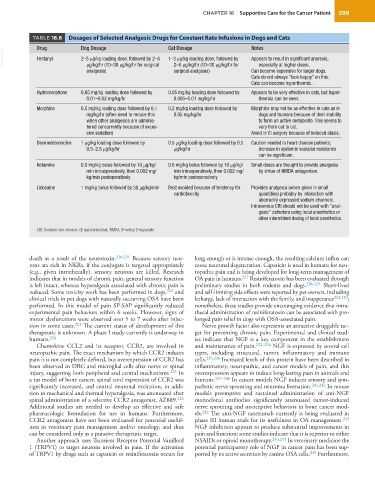Page 321 - Withrow and MacEwen's Small Animal Clinical Oncology, 6th Edition
P. 321
CHAPTER 16 Supportive Care for the Cancer Patient 299
TABLE 16.6 Dosages of Selected Analgesic Drugs for Constant Rate Infusions in Dogs and Cats
Drug Dog Dosage Cat Dosage Notes
VetBooks.ir Fentanyl 2–5 μg/kg loading dose, followed by 2–6 1–3 μg/kg loading dose, followed by Appears to result in significant anorexia,
μg/kg/hr (10–30 μg/kg/hr for surgical
especially at higher doses.
surgical analgesia)
analgesia) 2–6 μg/kg/hr (10–30 μg/kg/hr for Can become expensive for larger dogs.
Cats do not always “look happy” on this.
Cats can become hyperthermic.
Hydromorphone 0.05 mg/kg loading dose followed by 0.05 mg/kg loading dose followed by Appears to be very effective in cats, but hyper-
0.01–0.02 mg/kg/hr 0.005–0.01 mg/kg/hr thermia can be seen.
Morphine 0.5 mg/kg loading dose followed by 0.1 0.2 mg/kg loading dose followed by Morphine may not be as effective in cats as in
mg/kg/hr (often need to reduce this 0.05 mg/kg/hr dogs and humans because of their inability
when other analgesics are adminis- to form an active metabolite. This seems to
tered concurrently because of exces- vary from cat to cat.
sive sedation) Avoid in GI surgery because of induced stasis.
Dexmedetomidine 1 μg/kg loading dose followed by 0.5 μg/kg loading dose followed by 0.5 Caution needed in heart disease patients;
0.5–2.5 μg/kg/hr μg/kg/hr increase in systemic vascular resistance
can be significant.
Ketamine 0.5 mg/kg bolus followed by 10 μg/kg/ 0.5 mg/kg bolus followed by 10 μg/kg/ Small doses are thought to provide analgesia
min intraoperatively, then 0.002 mg/ min intraoperatively, then 0.002 mg/ by virtue of NMDA antagonism.
kg/min postoperatively kg/min postoperatively
Lidocaine 1 mg/kg bolus followed by 30 μg/kg/min Best avoided because of tendency for Provides analgesia (when given in small
cardiotoxicity quantities) probably by interaction with
aberrantly expressed sodium channels.
Intravenous CRI should not be used with “anal-
gesic” catheters using local anesthetics or
other intermittent dosing of local anesthetics.
CRI, Constant rate infusion; GI, gastrointestinal; NMDA, N-methyl D-aspartate.
death as a result of the neurotoxin. 220,221 Because sensory neu- long enough or is intense enough, the resulting calcium influx can
rons are rich in NKRs, if the conjugate is targeted appropriately cause neuronal degeneration. Capsaicin is used in humans for neu-
(e.g., given intrathecally), sensory neurons are killed. Research ropathic pain and is being developed for long-term management of
indicates that in models of chronic pain, general sensory function OA pain in humans. 227 Resiniferatoxin has been evaluated through
is left intact, whereas hyperalgesia associated with chronic pain is preliminary studies in both rodents and dogs. 228–231 Short-lived
reduced. Some toxicity work has been performed in dogs, 222 and and self-limiting side effects were reported by pet owners, including
clinical trials in pet dogs with naturally occurring OSA have been lethargy, lack of interaction with the family, and inappetance 223,229 ;
performed. In this model of pain SP-SAP significantly reduced nonetheless, these studies provide encouraging evidence that intra-
experimental pain behaviors within 6 weeks. However, signs of thecal administration of resiniferatoxin can be associated with pro-
motor dysfunctions were observed over 5 to 7 weeks after injec- longed pain relief in dogs with OSA-associated pain.
tion in some cases. 223 The current status of development of this Nerve growth factor also represents an attractive druggable tar-
therapeutic is unknown. A phase I study currently is underway in get for preventing chronic pain. Experimental and clinical stud-
humans. 224 ies indicate that NGF is a key component in the establishment
Chemokine CCL2 and its receptor, CCR2, are involved in and maintenance of pain. 232–234 NGF is expressed by several cell
neuropathic pain. The exact mechanism by which CCR2 induces types, including structural, tumor, inflammatory and immune
pain it is not completely defined, but overexpression of CCR2 has cells. 235,236 Increased levels of this protein have been described in
been observed in DRG and microglial cells after nerve or spinal inflammatory, neuropathic, and cancer models of pain, and this
injury, suggesting both peripheral and central mechanisms. 225 In overexpression appears to induce long-lasting pain in animals and
a rat model of bone cancer, spinal cord expression of CCR2 was humans. 237–240 In cancer models NGF induces sensory and sym-
significantly increased, and central neuronal excitation, in addi- pathetic nerve sprouting and neuroma formation. 241,242 In mouse
tion to mechanical and thermal hyperalgesia, was attenuated after models preemptive and sustained administration of anti-NGF
spinal administration of a selective CCR2 antagonist, AZ889. 226 monoclonal antibodies significantly attenuated tumor-induced
Additional studies are needed to develop an effective and safe nerve sprouting and nociceptive behaviors in bone cancer mod-
pharmacologic formulation for use in humans. Furthermore, els. 242 The anti-NGF tanezumab currently is being evaluated in
CCR2 antagonists have not been evaluated for potential useful- phase III human trials for its usefulness in OA management. 243
ness in veterinary pain management and/or oncology, and thus NGF inhibition appears to produce substantial improvements in
can be considered only as a putative therapeutic target. pain and function; some studies indicate that it is superior to either
Another approach uses Transient Receptor Potential Vanilloid NSAIDs or opioid monotherapy. 240,244 In veterinary medicine the
1 (TRPV1) to target neurons involved in pain. If the activation potential participatory role of NGF in cancer pain has been sup-
of TRPV1 by drugs such as capsaicin or resiniferatoxin occurs for ported by its active secretion by canine OSA cells. 245 Furthermore,

